Browse Primary Sources
Locate primary sources, including images, objects, media, and texts. Annotations by scholars contextualize sources.
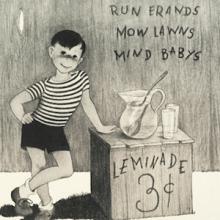
The Lemonade Stand
The lemonade stand is a widely used and recognized symbol of capitalism and in particular entrepreneurship. The selling of lemonade on the streets of New York can be traced back to when a New York youngster sold it to thirsty street car riders over 130 years ago. Its connection to youthful entrepreneurship has endured.
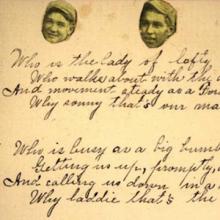
Christmas Poem, Pima Indian School
The poem and photographic collage is the work of students at the Pima Indian School boarding school near Phoenix, Arizona, and is part of an album probably owned by the school matron. The school was one of some 150 institutions for Indian wards of the U.S. Government.

Barbie Turns 21
Barbie—who is today the most famous doll in the world—was based on Lilli, a sexy and sassy German doll first produced in 1955. Co-founder of Mattel Inc., Ruth Hander transformed the Teutonic doll from floozy to fashion queen for American girls like her daughter, Barbara, after whom the doll was named.
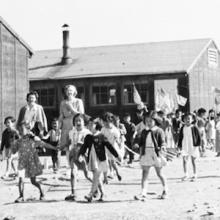
Schoolchildren at Minidoka Incarceration Camp
Minidoka incarceration camp, near Twin Falls in southern Idaho, was one of 10 incarceration camps run by the War Relocation Authority (WRA) that held citizens and non-citizens of Japanese descent during World War II. The 33,000 acres of arid desert were dominated by sagebrush, and residents contended with a harsh climate and poor living conditions.
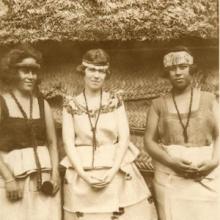
Margaret Mead, Coming of Age in Samoa
In 1928, Martha Mead published Coming of Age in Samoa, an anthropological work based on field work she had conducted on female adolescents in Samoa. In Mead's book that became a best seller and unleashed a storm of controversy, she argued that it was cultural factors rather than biological forces that caused adolescents to experience emotional and psychological stress.
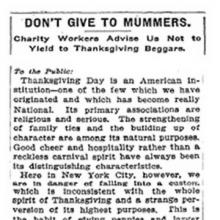
Thanksgiving Newspaper Article
Thanksgiving was not uniformly celebrated until major efforts to nationalize it were undertaken late in the nineteenth century. Despite Lincoln's proclamation that made Thanksgiving a national holiday during the Civil War, few Americans celebrated the holiday like middle-class Protestants in New England and the Mid-Atlantic states did.
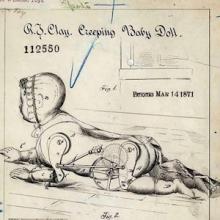
Creeping Baby Doll Patent
Strongly influencing the invention of Robert J. Clay's mechanized "Creeping Baby Doll" in 1871, were changing notions of childhood that fostered children's development.

Writing a Letter to Santa
Whether known as Saint Nicholas, Sinterklaas, Father Christmas, Kris Kringle, Babbo Natale, Christkind, Père Noël, Santa Claus ("Santa") or by many other names, this legendary gift-giver in European folklore and hagiography is well known around the world.
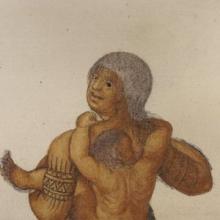
Carrying Native-American Babies
This watercolor (fig. 1) of a mother carrying her baby was painted c. 1585 by John White who explored the mid-Atlantic region with other Englishmen including Thomas Hariot. Hariot's A Briefe and True Report of the New Found Land of Virginia published in 1590 included an illustration based on White’s watercolor by engraver, Theodore de Bry. (fig. 2)
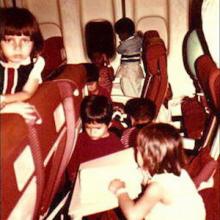
Operation Babylift
These photographs were taken on April 5, 1975 on one of the Pan Am passenger planes that airlifted Vietnamese orphans and Amerasian children of American servicemen and Vietnamese women for Operation Babylift.

Little Eva, The Flower of the South
Published around 1853, Little Eva, The Flower of the South is an anonymously written children's story based on Eva, the enormously popular character in Harriet Beecher Stowe's anti-slavery novel, Uncle Tom's Cabin (1852).
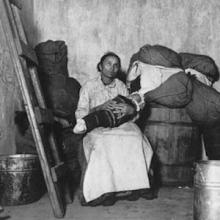
Italian Mother and Baby
"Italian Mother and Baby" appeared in Jacob Riis's How the Other Half Lives: Studies among the Tenements of New York (1890). This image captures the misery of urban poverty as well as the tenacity of life. It is infused with unmistakable sentimentalism and symbolism.
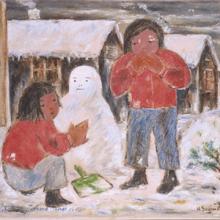
Girls Making Snowman
Motivated by wartime hysteria and racial sentiments following the Japanese attack on Pearl Harbor on December 7, 1941, President Franklin D. Roosevelt issued Executive Order 9066 that ordered the removal of Japanese Americans on the West Coast to internment camps in the interior.
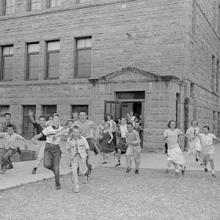
Last Day of School, Calgary
The children of various ages shown bursting through the doorway of the stone school building in Calgary, Alberta, have just been released for their summer vacation.
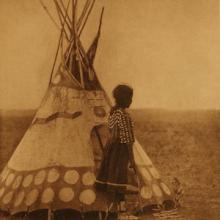
Piegan Play Tipi
The photograph, dated 1928, from the well-known ethnographic collection The North American Indian by Edward Edward S. Curtis, is a portrait of a young Piegan girl standing in front of a painted tipi, or conical tent. The label on the photograph by Curtis indicates that it is a play tipi, meaning a child-sized version of the tents used for families among this Native American group.
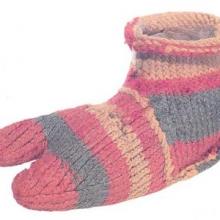
Child's Sock
Archaeologist W. M. Flinders Petrie found this child's sock, dated to the 2nd century C.E., in a cemetery at Oxyrhyncus, a Greek monastic centre on the banks of the Nile in Egypt. The sock is made of wool yarn in a technique called "sprang," or loop knitting, in which short pieces of yarn were looped in a circular pattern using a needle.
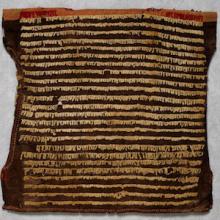
Infant's Tunics
These two infant tunics, found south of Cairo by archaeologists, date to the period after the Arab conquest of Egypt. The first tunic, measuring 45 centimeters long and 47 cm wide (17.7 x 18.5 inches), was made of a single length of hand-woven brown wool folded in half at the shoulders and sewn on the sides, leaving openings for the arms and vents at the hand-stitched hem for mobility.
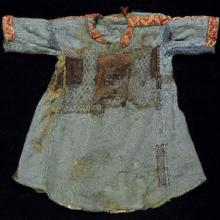
Children's Tunics
These two children's tunics, found in Egypt by archaeologist Wm. Flinders Petrie, date to the Islamic period, 9th or 10th century. The blue tunic measures 45.5 cm long and 51 cm wide (18 x 20 inches). The tunic is made of three different fabrics cut from an adult garment into 11 separate pieces, with sleeves and side gores.
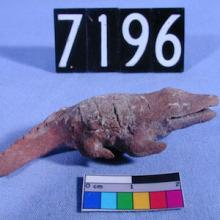
Mud Crocodile Toy
This small sculpture of a crocodile is made of Nile River mud, and was probably a toy fashioned by a child at play. The crocodile was a familiar monster to children living along the Nile—an object of fear and fascination. This 5 centimeter (2 inch) long mud figurine has open jaws, slits for eyes, a curved tail that seems to whip it through the water, and feet that seem to be in motion.
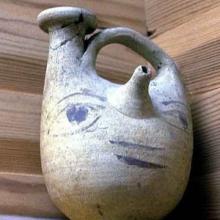
Phoenician Baby Bottle
The Phoenician terracotta vessel features a human face, the nose forming a narrow spout. The bottle is an archaeological find from Carthage, near modern Tunis, dated to 399 BCE-200 BCE. Archaeologists believe this object was a baby bottle. It could have been used to feed diluted wine with honey or other sweet liquid such as juice, milk, or thin porridge, cooked cereal made from ground grain.